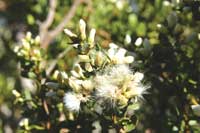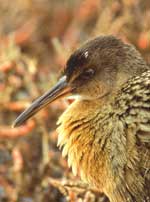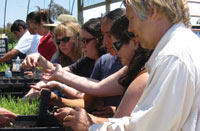
 GIVEN HALF A CHANCE, nature does most of the work. Tidal marsh restoration begins with bringing back water from San Francisco Bay. As water flows in and out of the marsh with the rising and falling of the tides, conditions for tidal marsh plants develop. The tides transport nutrients and seeds from other marshes. The rest is up to us. We use the greenhouse to grow plants that are locally uncommon or rare.
GIVEN HALF A CHANCE, nature does most of the work. Tidal marsh restoration begins with bringing back water from San Francisco Bay. As water flows in and out of the marsh with the rising and falling of the tides, conditions for tidal marsh plants develop. The tides transport nutrients and seeds from other marshes. The rest is up to us. We use the greenhouse to grow plants that are locally uncommon or rare.
 GARDENING FOR WILDLIFE
GARDENING FOR WILDLIFE
Restoring tidal marsh is a big step towards restoring wildlife habitats. Plants provide food, shelter, and nest sites for all types of wildlife including insects, birds, mammals, and fish. Song sparrows search for spiders living in marsh plants, salt marsh harvest mice build nests there, and rails seek refuge from high tides and predators.
 THE NURSERY CONNECTION
THE NURSERY CONNECTION
Seeds and cuttings of native plants are collected and grown in the nursery. The greenhouse provides just the right amount of light, heat, and moisture for growth. When the plants are ready, after months of care and attention, we take the next step - restoring them to the environment - at just the right time and in just the right place.
|



